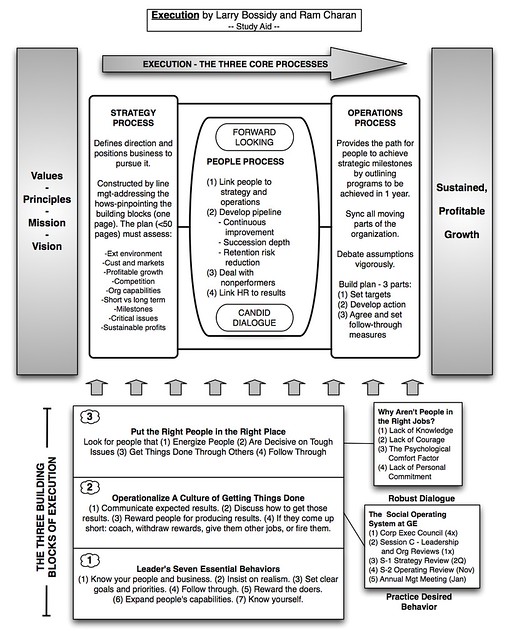The subtitle, The Discipline of Getting Things Done, drew me into this book. It’s a common theme these days; David Allen’s book Getting Things Done (GTD) has a cult-like following amongst the internet set, popular websites like Lifehacker and 43F espouse the benefits of GTD and personal productivity, and it has become popular to say things like “git ‘er done” with a fake southern accent (I’m guilty).
I did not expect this book to address any aspect of personal productivity, and it doesn’t. What it does address is how a CEO gets the job done. It’s basically CEO 101 by a rock-star CEO (Bossidy) and an accomplished consultant/academic (Charan). It’s a management book; a treatise on the ingredients that your company needs to consistently deliver results. Bossidy and Charan detail the building blocks and processes that they feel will allow your company to bridge the gap between what your company wants and what your company eventually gets.
I drew a picture:
This book is laid out in a straightforward manner. Chapter 1 begins by identifying the problem, referred to by Bossidy and Charan as “the gap nobody knows.” They follow it up with a chapter recounting the real-world execution successes and failures of three companies (Xerox, Lucent Technologies, and EDS). These examples drive home why the authors feel the discipline of execution is so important for your company. The rest of the book provides specifics, with lots of examples, for the three building blocks and three processes outlined in the picture above. Your company’s leadership and staff must achieve excellence in all of these areas in order to have the best chance of achieving execution success.
The target audience for this book may appear to be grad students and middle managers that aspire to be a CEO some day. However, I think this book is also appropriate for first-year staffers that are embarking on any sort of career in an industrial corporation. It gives an excellent description of the internal workings of a business entity and how processes like strategic planning, budgeting, performance reviews, and quarterly management reviews are linked. These processes, along with all of the informal, cross-departmental dialogue a company has, are referred to as the “Social Operating Mechanism.” By linking all of this, Bossidy and Charan take some of the mystery out of why people have to participate in such apparently mundane things as departmental budgets, monthly variance analyses, and annual people assessments. If I would have read an overview like this when I joined corporate America after leaving public accounting, it would have accelerated my learning curve on many aspects of management.
This is not a complicated book. Just by the nature of the topic, it’s more practice than it is theory. Bossidy and Charan clearly explain the nuts and bolts of how to excel at each aspect of execution without a lot of business jargon. I think this book has a place in your business library because you need something that links the big picture to the bottom line, so to speak. It may fit nicely somewhere between Competitive Advantage and The Goal.
